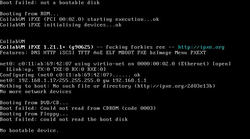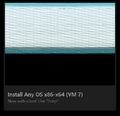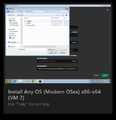VM7: Difference between revisions
No edit summary |
|||
| (11 intermediate revisions by 4 users not shown) | |||
| Line 1: | Line 1: | ||
{{DISPLAYTITLE:VM7 (Install Any OS (Modern OSes) x86-x64)}} |
{{DISPLAYTITLE:VM7 (Install Any OS (Modern OSes) x86-x64)}} |
||
{{Infobox VM |
|||
|title = Install Any OS (Modern OSes) x86-x64 (VM 7) |
|||
|screenshot = VM7_def.png |
|||
|introduced = December 2021 |
|||
|os = User-decided |
|||
|arch = x64 |
|||
|node = vm7 |
|||
|previousvm = [[VM6]] |
|||
|next = [[VM8]] |
|||
}} |
|||
| ⚫ | VM7 is a Install Any OS VM ([[VM8|and a series of Install Any OS VMs]]) that debuted in December 2021. The VM allows any user to install any OS they want, either through Lily or Dartz's ISO folder or from a website using <code>!httpcd (url)</code>. A list of them can be found at [http://computernewb.com/~dartz/isos http://computernewb.com/~dartz/isos] and [http://computernewb.com/~lily/ISOs http://computernewb.com/~lily/ISOs]. |
||
: [[VM8|VM8 >]] |
|||
| ⚫ | VM7 is a VM that debuted in December 2021. The VM allows any user to install any OS they want, either through Lily or Dartz's ISO folder or from a website using <code>!httpcd (url)</code>. A list of them can be found at [http://computernewb.com/~dartz/isos http://computernewb.com/~dartz/isos] and [http://computernewb.com/~lily/ISOs http://computernewb.com/~lily/ISOs]. |
||
There is also an alternate version of VM7 for older operating systems you can use, called VM8. [[VM8|You can view the article for it here.]] |
There is also an alternate version of VM7 for older operating systems you can use, called VM8. [[VM8|You can view the article for it here.]] |
||
Users interact with the VM through a bot named [[AnyOSInstallBot]]. Another way users can interact with the VM is the default [[iPXE]] which is named "CollabVM iPXE", a custom version of iPXE. This iPXE version behaves similar to vanilla iPXE, VM8 does not have this however. |
Users interact with the VM through a bot named [[AnyOSInstallBot]]. Another way users can interact with the VM is the default [[iPXE]] which is named "CollabVM iPXE", a custom version of iPXE. This iPXE version behaves similar to vanilla iPXE, VM8 does not have this however. |
||
[[File:VM7_def.png|thumb|right|VM7 when it is in its default state]] |
|||
__TOC__ |
__TOC__ |
||
| ⚫ | |||
| ⚫ | |||
* Windows 2000 to 11 - Older than 2000 works but no networking |
|||
| ⚫ | |||
| ⚫ | |||
| ⚫ | |||
| ⚫ | |||
* GhostBSD - Mouse doesn't work |
|||
| ⚫ | |||
| ⚫ | |||
| ⚫ | |||
| ⚫ | |||
==== Doesn't work at all ==== |
|||
* FreeBSD - Kernel panicks on boot while booting 64-bit ISO and locks up while booting 32-bit ISO |
|||
== Facts about VM7 == |
== Facts about VM7 == |
||
| ⚫ | |||
| ⚫ | |||
| ⚫ | |||
| ⚫ | |||
| ⚫ | |||
| ⚫ | |||
* Another retard thought [[AnyOSInstallBot]] was a shell script, and tried to execute a script to delete the user directory but failed horribly. |
|||
* An extremely common occurrence on VM8: People tend to try and install 64-bit OSes on Install Any OS ('''OLD OSES'''), which is 32-bit. It always seems like they read "older OSes" and think "It's just a clone of VM7" and try to insert his Pissta or Server 2008 CD into it. |
|||
* Most people that come on here don't know how to use part of the <code>boot.netboot.xyz</code> menu. They choose Windows, load the installer from nothing (boot with no base URL) (''Keep in mind, that choosing Windows expects you to load WIMs from a remote source''), leave the base URL blank when they are PROMPTED to put something there, load it again, leave the base url blank, try changing the architecture, and repeat. |
|||
| ⚫ | |||
* You are better off using this VM when no one is there (Join at like 1:00 AM EST), because I guarantee you one faggot is gonna come, insert his Pissta or Server 2008 (or maybe CHOCOLMOS) CD and install that over whatever you are installing. |
|||
| ⚫ | |||
* People enjoy installing operating systems that are already their own VMs. Instead of doing that, try installing some really obscure OS or a bootleg from Crustywindows. |
* People enjoy installing operating systems that are already their own VMs. Instead of doing that, try installing some really obscure OS or a bootleg from Crustywindows. |
||
* If you want to install Windows 7 on VM7, Consider doing !lilycd WinCHOC.iso, it's literally a [[CHOCOLATEMAN]] themed version of Windows. Make sure to select Ultimate during setup. |
|||
* If you don't want to wait so long for <code>!reboot</code>, you can alternatively open the webapp OSK and soft reboot the virtual machine by pressing Ctrl+Alt+Delete. |
* If you don't want to wait so long for <code>!reboot</code>, you can alternatively open the webapp OSK and soft reboot the virtual machine by pressing Ctrl+Alt+Delete. |
||
* When booting, go to iPXE command line and type in <code>exit</code>, this way you don't have to wait for iPXE to tell you that there is no network devices then let you boot to CD or floppy. |
* When booting, go to iPXE command line and type in <code>exit</code>, this way you don't have to wait for iPXE to tell you that there is no network devices then let you boot to CD or floppy faster. |
||
* The best bootset order is <code>nad</code>. Why? Not because that's |
* The best bootset order is <code>nad</code>. Why? Not because that's slang for testicles, but because by using the sanboot command in iPXE, you can still boot to the hard drive by typing in <code>sanboot -d 0x80</code>. |
||
* Actually, the best bootset order depends on how you are going to install something on VM7. You can do <code>dc</code> if you're going to insert a CD to install an OS, and then eject it later and boot to the OS faster. |
|||
== Gallery == |
== Gallery == |
||
| Line 60: | Line 42: | ||
VM8Default.PNG | VM8 when restored from the snapshot. Notice how it does not have "CollabVM iPXE" |
VM8Default.PNG | VM8 when restored from the snapshot. Notice how it does not have "CollabVM iPXE" |
||
VM8XP.PNG | People installing Windows XP Professional on VM8 |
VM8XP.PNG | People installing Windows XP Professional on VM8 |
||
OSX-VM7.png | OS X 10.8.2 running on VM7 |
|||
</gallery> |
</gallery> |
||
| ⚫ | |||
| ⚫ | |||
* Windows Vista to 11 |
|||
| ⚫ | |||
| ⚫ | |||
| ⚫ | |||
| ⚫ | |||
* NetBSD |
|||
* GhostBSD - utouch-kmod is required for absolute mouse input. |
|||
| ⚫ | |||
| ⚫ | |||
| ⚫ | |||
* Mac OS X 10.8 "Mountain Lion" - Niresh's 10.8.2 works on it, however not absolute mouse input and no ethernet unless you install a kext. Use command <code>!httpcd https://egg.l5.ca/files/iso/10.8.iso</code> |
|||
== OSes that work but have issues == |
|||
*Windows XP - You need to load a driver before the installer, or else the setup won't detect any disks: |
|||
:Run <code>!flp Driver/ich9-flp.img</code> |
|||
:As soon as the text setup loads, press F6 |
|||
:Press S to show a list of drivers, and select "'''Intel(R) ICH9R/DO/DH SATA AHCI Controller'''" |
|||
:Hit enter. The install should proceed as normal. |
|||
| ⚫ | |||
* FreeBSD - 64-bit panics due to something with APIC and 32-bit gets stuck on "Timecounters tick every 10.000 msec" |
|||
[[Category:Main_VMs]] |
[[Category:Main_VMs]] |
||
Latest revision as of 18:01, 2 May 2023
| CollabVM virtual machine | |
 | |
| Introduced | December 2021 |
|---|---|
| OS | User-decided |
| Architecture | x64 |
| Node ID | vm7 |
| Previous VM | VM6 |
| Next VM | VM8 |
VM7 is a Install Any OS VM (and a series of Install Any OS VMs) that debuted in December 2021. The VM allows any user to install any OS they want, either through Lily or Dartz's ISO folder or from a website using !httpcd (url). A list of them can be found at http://computernewb.com/~dartz/isos and http://computernewb.com/~lily/ISOs.
There is also an alternate version of VM7 for older operating systems you can use, called VM8. You can view the article for it here.
Users interact with the VM through a bot named AnyOSInstallBot. Another way users can interact with the VM is the default iPXE which is named "CollabVM iPXE", a custom version of iPXE. This iPXE version behaves similar to vanilla iPXE, VM8 does not have this however.
Facts about VM7
- Forkies usually come on VM7 to eject the CD and install some other OS over the one you were attempting to install or type !reboot and !eject cd in the middle of an install when you are using the system.
- Due to the TPM 2.0 requirements of Windows 11 (and the fact that VM7 does not have a vTPM), and also annoying children trying to install it, attempting to insert the ISO will insert "Windows 7 Haunted Edition" instead
- AnyOSInstallBot may not be present sometimes due to it being offline or an admin kicking it (likely due to abuse of the bot)
Tips for both VM7 and VM8
- People enjoy installing operating systems that are already their own VMs. Instead of doing that, try installing some really obscure OS or a bootleg from Crustywindows.
- If you don't want to wait so long for
!reboot, you can alternatively open the webapp OSK and soft reboot the virtual machine by pressing Ctrl+Alt+Delete.
- When booting, go to iPXE command line and type in
exit, this way you don't have to wait for iPXE to tell you that there is no network devices then let you boot to CD or floppy faster.
- The best bootset order is
nad. Why? Not because that's slang for testicles, but because by using the sanboot command in iPXE, you can still boot to the hard drive by typing insanboot -d 0x80.
- Actually, the best bootset order depends on how you are going to install something on VM7. You can do
dcif you're going to insert a CD to install an OS, and then eject it later and boot to the OS faster.
Gallery
-
People installing a post-reset Vista build (and failing, as you can see)
-
Windows CHOCOLATEMAN Edition running on VM7
-
VM8 when restored from the snapshot. Notice how it does not have "CollabVM iPXE"
-
People installing Windows XP Professional on VM8
-
OS X 10.8.2 running on VM7
OS Compatibility Reference Sheet for VM7
OSes that work flawlessly
- Windows Vista to 11
- Any GNU/Linux distribution with VirtIO modules built in
- Any Windows 2000 to 11 bootleg from Crustywindows
- OpenBSD
- DragonFlyBSD
- NetBSD
- GhostBSD - utouch-kmod is required for absolute mouse input.
- OmniTribblix
- OpenIndiana
- 9front
- Mac OS X 10.8 "Mountain Lion" - Niresh's 10.8.2 works on it, however not absolute mouse input and no ethernet unless you install a kext. Use command
!httpcd https://egg.l5.ca/files/iso/10.8.iso
OSes that work but have issues
- Windows XP - You need to load a driver before the installer, or else the setup won't detect any disks:
- Run
!flp Driver/ich9-flp.img - As soon as the text setup loads, press F6
- Press S to show a list of drivers, and select "Intel(R) ICH9R/DO/DH SATA AHCI Controller"
- Hit enter. The install should proceed as normal.
OSes that don't work at all
- FreeBSD - 64-bit panics due to something with APIC and 32-bit gets stuck on "Timecounters tick every 10.000 msec"




